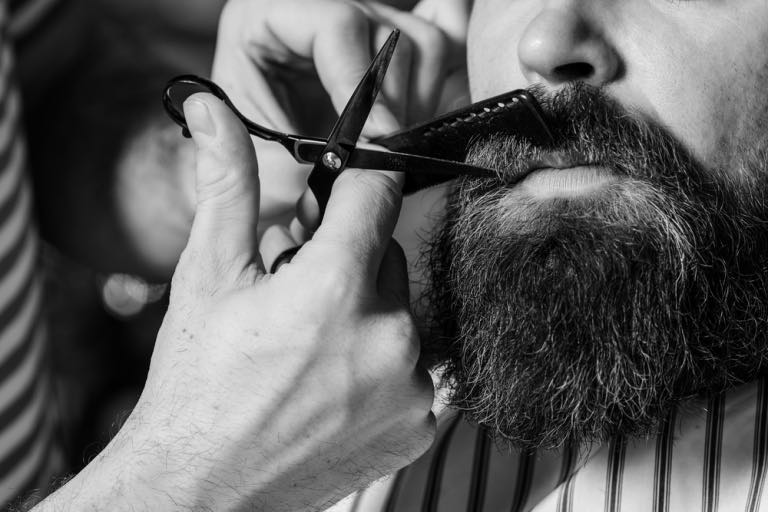Why You’re Doing It Wrong: The Perfect Guide on How to Shape a Beard

Most people think shaping a beard is as simple as running a trimmer over your face and hoping for the best. And let’s be honest, who hasn’t looked in the mirror post-trim and thought, “Close enough”? Unfortunately, that’s how you’re doing it wrong.
Many well-meaning beard enthusiasts make the classic mistake of ignoring their face shape and just going for the latest trendy style. It’s like trying to fit a square peg into a round hole. And don’t get me started on the “one-size-fits-all” approach that most seem to adopt.
Why is this wrong? Because how to shape a beard isn’t about following trends blindly or assuming your beard will naturally fall into place. It’s about precision, understanding your unique facial features, and yes, a bit of artistry. The goal is to enhance your natural look, not fight against it.
So, let’s break down the perfect guide on how to shape a beard.
Face Shapes and Their Impact on Beard Styles
Understanding your face shape is the secret to mastering how to shape a beard. Just like your favorite pair of jeans, not every style suits everyone, and it’s time to stop pretending otherwise. Whether you’re considering beard trimming services or figuring out how to shape a long beard, let’s break it down:
Round Faces
Got a round face? Then, you need to think of angles. Angular styles are your best friend because they add much-needed definition. Opt for a beard that’s shorter on the sides and fuller on the bottom. This approach creates the illusion of a longer, more defined jawline, making you look less like a cherub and more like a chiseled gentleman.
Square Faces
Square faces already have that strong jawline—lucky you! But to avoid looking too boxy, aim for a beard with a rounded chin. Softening those edges will balance your features perfectly. Think of it as a way to dial down the sharpness without losing that strong, commanding presence.
Oval Faces
Oval faces are the unicorns of beard shaping. Almost every style looks good on you, so feel free to experiment. Long beards, short beards, goatees—take your pick. Your main task is to ensure the beard is well-groomed and suits your personal style. This flexibility makes the search for the best beard trimming services more of an adventure than a necessity.
Rectangular Faces
For those with rectangular faces, fuller sides and shorter bottoms are key. This style helps balance out your face’s length, avoiding that “horse-face” effect. Fuller sides will give you a more proportional look, making your features appear more harmonious.
Why It Matters
Choosing the right beard style for your face shape isn’t just about aesthetics; it’s about enhancing your natural features and boosting your confidence. If you’ve ever wondered how to shape a long beard or make the most of beard trimming services, understanding your face shape is the first step to getting it right.
Each face shape has its unique requirements, and tailoring your beard to these needs will elevate your look from “just okay” to “absolutely stunning.” Trust the process, and you’ll never have to endure another awkward beard phase again.
Essential Tools for Shaping a Beard
When it comes to how to shape your beard, having the right tools is like having the perfect ingredients for a gourmet meal. You wouldn’t use a butter knife to fillet a fish, so why settle for subpar grooming tools?
Here are the essentials that will make all the difference.
Quality Trimmer
A quality trimmer is the backbone of beard shaping. Look for one with adjustable settings, allowing you to fine-tune the length with precision. Whether you’re aiming for a 5 o’clock shadow or a fuller look, adjustable settings help you achieve the exact length you need. And yes, it’s essential for perfecting the shape a beard under chin—a tricky spot that demands accuracy. A good trimmer isn’t just about the blades; it’s about control and versatility.
Sharp Scissors
Scissors might seem old school, but they’re indispensable for detailed trimming. Those pesky split ends? Snip them away. Need to fine-tune the mustache or even out your beard’s edges? Scissors are your best friend. The key is sharpness. Dull scissors will leave you with a jagged mess, but a sharp pair will give you the clean lines that make your beard look intentional, not accidental.
Comb
A good comb does more than just detangle. It helps you shape a beard under chin, guides your trimmer, and ensures even cutting. Opt for a comb with both wide and narrow teeth to tackle different beard lengths and textures. Using a comb while trimming helps you see the lines clearly, so you don’t end up with an uneven mess. Plus, it’s great for distributing beard oil evenly—more on that next.
Beard Oil
Speaking of beard oil, it’s not just a luxury—it’s a necessity. A well-maintained beard isn’t just about appearance; it’s about health. Beard oil keeps your beard soft, shiny, and free of dreaded beardruff. It also hydrates the skin underneath, preventing irritation and flakiness. Regular use of beard oil makes the grooming process smoother and the results more polished.
How to Shape a Beard?
Getting your beard to look just right isn’t rocket science, but it does require some know-how. Here’s how to shape a beard step-by-step, ensuring you avoid common mistakes and achieve that perfectly groomed look.
Preparation Steps
Start Clean and Dry
Always begin with a clean and dry beard. Trimming wet hair can lead to over-trimming because hair appears longer when it’s wet. Dry hair gives you a true sense of the length and volume, ensuring accuracy in your trim.
Comb It Out
Before you start shaping, comb your beard thoroughly. This untangles any knots and ensures the hair lays naturally. A smooth, tangle-free beard is much easier to shape precisely.
Shaping Process
Defining the Neckline
Here’s where many go wrong. Your neckline should be defined carefully to avoid that unsightly neckbeard look.
- Placement: Place two fingers above your Adam’s apple. This is where your neckline should begin.
- Trimming: Trim everything below this line. Be firm but careful to maintain a natural look.
Creating the Cheek Line
Your cheekline can make or break your beard’s appearance. A natural cheek line often works best, but some might prefer a straight or slightly curved line for a sharper look.
- Natural Cheek Line: Follow the natural growth pattern of your beard. If you want a cleaner look, a straight or slightly curved line from the top of your ear to the corner of your mouth is ideal.
Trimming the Length
The actual trimming process requires a steady hand and a good eye.
- Starting Point: Begin with a higher guard setting on your trimmer. You can always take more off, but you can’t put it back.
- Direction: Trim in the direction of hair growth. This prevents tugging and ensures an even trim.
Detailing with Scissors
Once the bulk of the trimming is done, it’s time for the details.
- Focus Areas: Pay close attention to the mustache and any stray hairs. Use scissors for these areas to avoid over-trimming with the trimmer.
Maintaining Symmetry
Nothing ruins a good beard like an uneven trim.
- Check Regularly: Step back and check your work in the mirror frequently. Make sure both sides are symmetrical and balanced.
Avoiding Common Beard Shaping Mistakes
Over-Trimming
Remember, you can always trim more, but you can’t replace what’s been cut. Less is more when you start trimming.
Ignoring the Neckline
A poorly defined neckline can make even the best-shaped beard look scruffy. Always trim below the designated neckline.
Neglecting Beard Care
Regular washing, conditioning, and oiling keep your beard healthy and manageable. Skipping these steps can lead to a rough, unruly beard that’s hard to shape.
Regular Maintenance for a Sharp Look
Let’s be clear: a well-shaped beard isn’t a set-it-and-forget-it deal. Regular maintenance is your ticket to keeping that sharp look.
Skipping this part? Well, that’s how you’re doing it wrong.
Daily Routine
Yes, daily. Start with a comb-through to detangle and direct the hairs. This isn’t just for style; it promotes even growth and prevents the dreaded beard itch. Follow up with beard oil. Not only does it keep your beard soft and manageable, but it also nourishes the skin underneath.
Daily care ensures you won’t end up with a scraggly mess below the jawline.
Weekly Routine
Here’s where precision pays off. Each week, trim any stray hairs that have decided to go rogue. This isn’t a full-on trim and shape-a-beard session but a touch-up to keep things tidy. Use a quality trimmer and scissors for accuracy. Your beard’s shape should enhance your facial features, so maintain that outline regularly. A quick check-in each week prevents the gradual decline into a shapeless fuzzball.
Monthly Routine
This is your deep maintenance routine. Once a month, give your beard a thorough trim. This is when you really refine the shape, paying special attention to how to shape the beard under the chin and around the cheeks. Use your trimmer’s adjustable settings to get the length just right, and don’t shy away from using scissors for the finer details. This step is crucial for maintaining a sharp, clean look and keeping your beard healthy.




